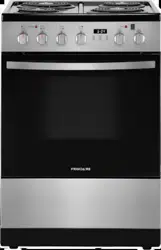Documents: Go to download!
User Manual
- User Manual - (English)
- User Manual - (Spanish)
- Product spec sheet - (English)
- Installation Intructions - (English)
- BEFORE SETTING SURFACE CONTROLS
- BEFORE USING OVEN
- OVEN CONTROLS
- CARE AND CLEANING
- Troubleshooting
Table of contents
Use & Care Electric Range
BEFORE SETTING SURFACE CONTROLS
Using Proper Cookware
- The size and type of cookware used will influence the heat setting needed for best cooking results. Be sure to follow the recommendations for using proper cookware as illustrated in Figure 1 and Figure 2.
- Check for flatness by rotating a ruler across the bottom of the cookware (see Figure 1). Cookware should have flat bottoms that make good contact with the entire surface of the heating element (see Figure 2).
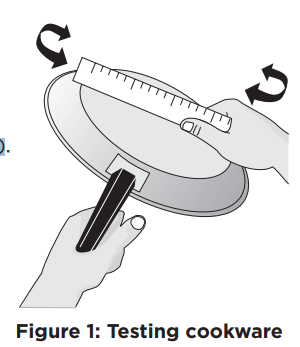
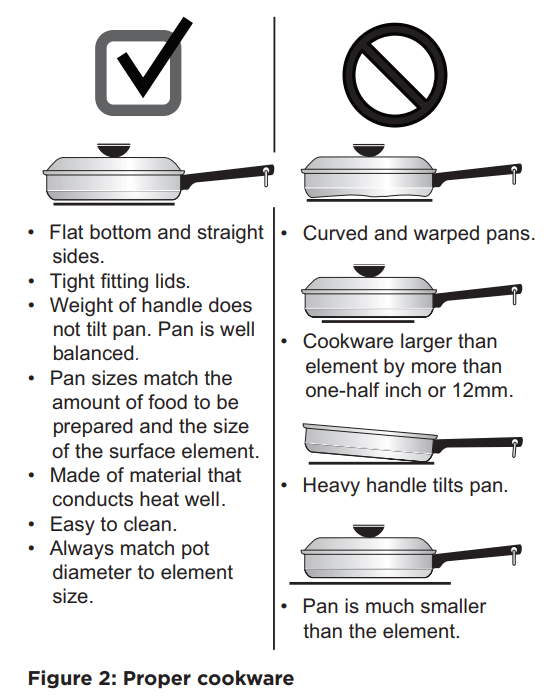
Cookware Material Types
The cookware material determines how evenly and quickly heat is transferred from the surface element to the pan bottom. The most popular materials available are:
- Aluminum - Excellent heat conductor. Some types of food will cause it to darken (Anodized aluminum cookware resists staining and pitting).
- Copper - Excellent heat conductor but discolors easily (see Aluminum).
- Stainless - Slow heat conductor with uneven cooking results. Durable, easy to clean, and resists staining.
- Cast Iron - A slow heat conductor, but will retain heat very well. Cooks evenly once cooking temperature is reached.
- Porcelain-enamel on metal - Heating characteristics will vary depending on base material.
- Glass - Slow heat conductor.
IMPORTANT
- Do not allow aluminum foil or ANY material that can melt to make contact with the radiant surface element. If these items melt on the cooktop, they will damage the cooktop
- NEVER place or straddle a cooking utensil over two different surface cooking areas at the same time. Incorrect use may damage the cooktop.
About the Radiant Surface Elements
- The element temperature rises gradually and evenly. As the temperature rises, the element will glow red. To maintain the selected setting the element will cycle on and off. The heating element retains enough heat to provide a uniform and consistent heat during the off cycle.
- For efficient cooking, turn the element off several minutes before cooking is complete. This will allow residual heat to complete the cooking process.
- The type and size of cookware, the number of surface elements in use and their settings are all factors that will affect the amount of heat that will spread to areas beyond the surface elements. The areas surrounding the elements may become hot enough to cause burns.
CAUTION
- Surface elements may appear to have cooled after they have been turned off. The element surface may still be hot, and burns may occur if the element or surrounding area is touched before it has cooled to a safe temperature.
- Do not place flammable items such as plastic salt and pepper shakers, spoon holders, or plastic wrapping on top of the range when it is in use. These items could melt or ignite. Potholders, towels, or wooden spoons could catch fire if placed too close to the surface elements.
- Do not use aluminum foil to line surface drip bowls or reflector pans. Improper installation of these liners may result in risk of electric shock or fire.
Element On Indicator Lights
- The ELEMENT ON indicator light will turn on when one or more elements are turned on. A quick glance at this indicator light when cooking is finished is an easy check to be sure all surface elements are turned off.

NOTE
- Radiant elements have a limiter that allows the element to cycle on and off, even at the HI setting.
- Be sure to read detailed instructions for coil cooktop cleaning in the “Care and Cleaning” section and “Before You Call” checklist section of this Use and Care Guide.
Home Canning
Be sure to read and observe all the following points when home canning with your appliance. Check with the USDA (United States Department of Agriculture) Web site and be sure to read all the information they have available as well as follow their recommendations for home canning procedures.
- Use only a completely flat bottom canner with no ridges that radiate from the bottom center when home canning. Heat is spread more evenly when the bottom surface is flat. Use a straight-edge to check canner bottom.
- Make sure the diameter of the canner does not exceed 1 inch beyond the surface element markings or burner.
- It is recommended to use smaller diameter canners on electric coil and ceramic glass cooktops and to center canners on the burner grates.
- Start with hot tap water to bring water to boil more quickly.
- Use the highest heat setting when first bringing the water to a boil. Once boiling is achieved, reduce heat to lowest possible setting to maintain that boil.
- Use tested recipes and follow instructions carefully. Check with your local Cooperative Agricultural Extension Service or a manufacturer of glass jars for the latest canning information.
- It is best to can small amounts and light loads.
- Do not leave water bath or pressure canners on high heat for an extended amount of time.
CAUTION: Canning can generate large amounts of steam. Use extreme caution to prevent burns. Always raise the lid to vent steam away from you. Safe canning requires that harmful micro-organisms are destroyed and the jars are sealed completely. When canning in a water bath canner, a gentle but steady boil must be maintained continuously for the required time.
Single radiant surface elements
The cooktop has four single coil surface elements.
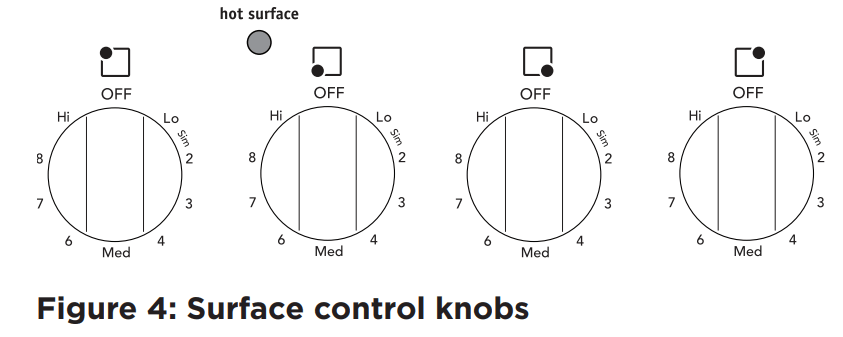
To operate an element:
- Place correctly sized cookware on the element.
- Push in and turn the surface control knob in either direction (Figure 5) to the desired setting (refer to the “Suggested radiant surface element settings” in Table 1).
- When cooking is complete, turn the radiant surface element OFF before removing the cookware.
Start most cooking operations on a higher setting and then turn to a lower setting to finish cooking. The surface control knobs do not have to be set exactly on a particular spot. Use the graphics provided as a guide and adjust the control knob as needed (see Figure 1).
A glowing red surface heating area extending beyond the bottom edge of the cookware indicates the cookware is too small for the surface heating area.
Suggested radiant surface element settings
- The suggested settings found in Table 1 below are based on cooking with medium-weight aluminum pans with lids. Settings may vary when using other types of pans.
Table 1: Suggested settings for radiant elements
Settings | Type of Cooking |
High (HI) | Start most foods; bring water to a boil and pan broiling . |
Medium High (8) | Continue a rapid boil; frying, deep fat frying |
Medium (6) | Maintain a slow boil; thicken sauces and gravies; steaming vegetables |
Medium Low (2-4) | Keep foods cooking; poaching and stewing |
Low (LO) | Keep warm, melting and simmering |

BEFORE USING OVEN
Oven Vent Location
- The oven vent is located under the control panel. When the oven is on, warm air passes through this vent.. This venting is necessary for proper air circulation in the oven and good baking results. Do not block the oven vent. Never close off the openings with aluminum foil or any other material. Steam or moisture may appear near the oven vent. This is normal.
The Cooling Fan
- The cooling fan operates during cooking. Air is expelled through the vents between the oven door and the control panel as shown in Figure 5.
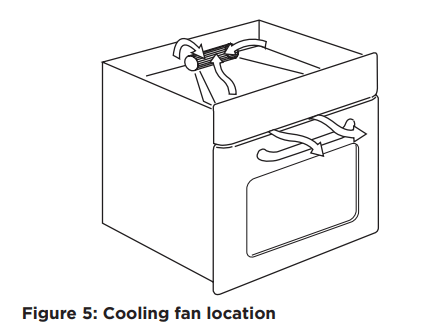
WARNING: Protective Liners — Do not use aluminum foil or any other material or liners to line the oven bottom, walls, racks or any other part of the range. Doing so will alter the heat distribution, produce poor baking results, and possibly cause permanent damage to the oven interior. Improper installation of these liners may result in risk of electric shock or fire. During self clean, temperatures in the oven will be hot enough to melt foil.
CAUTION
- Always use pot holders or oven mitts when using the oven. When cooking, the oven interior, oven exterior, oven racks, and cooktop will become very hot which can cause burns.
- To prevent possible damage to the oven, do not attempt to close the oven door until all the oven racks are fully positioned back inside the oven cavity
Flat Oven Rack
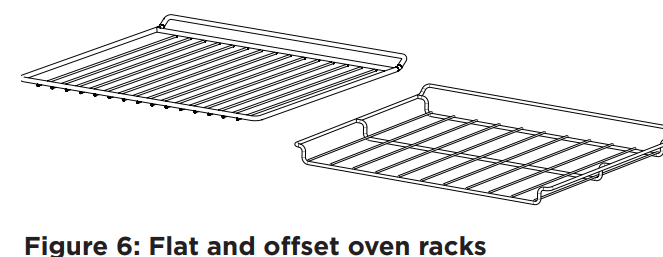
- This oven comes with a flat oven rack and an offset oven rack that may be used for most cooking needs.
Removing, Replacing, and Arranging Flat or Offset Oven Racks
- Always arrange the oven racks when the oven is cool.
- To remove - Pull the oven rack straight forward until it reaches the stop position. Lift up front of oven rack slightly and slide out.
- To replace - Place the oven rack on the rack guides on both sides of oven walls. Tilt the front of oven rack upward slightly and slide the oven rack back into place. Be sure oven racks are level before using.

Air Circulation in the Oven
- The rack has a special shape in the rear which helps with the heat circulation.
- Do not push the baking tray all the way to the back wall of the cavity. This prevents the heat from circulating around the tray. The food may be burnt, especially in the rear part of the tray.
- For best air circulation when baking, allow a space of 2 inches (5 cm) around the cookware for proper air circulation. Be sure pans and cookware do not touch each other, the oven door, sides, or back of the oven cavity.
- Hot air must be able to circulate around cookware for even heat to reach the food.
OVEN CONTROLS
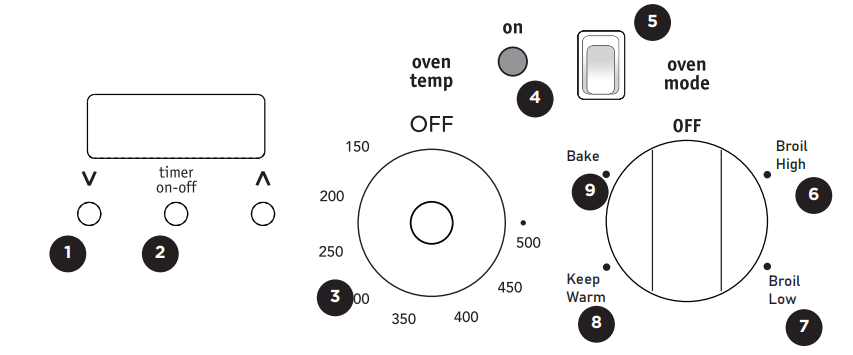
Oven Control Features
- Up / Down arrows - Use to adjust and set the appliance’s timer functionality.
- Timer on-off - Use to set or cancel the minute timer. The minute timer does not start or stop any cooking function.
- Oven temp knob - Use to select the desired cooking temperature.
- Oven indicator light - Glows each time the oven cycles on to maintain the set oven temperature.
- Oven light - Use this switch to turn the internal oven light on or off.
- Roast- Use to select the roasting function, best for cooking tender cuts of beef, lamb, pork, and poultry.
- Bake - Use to enter the normal baking mode temperature and start a normal baking function.
- Lo Broil - Use to set the broil function.
- Hi Broil - Use to set the broil function.
Operating oven light
- The interior oven light will automatically turn on when the oven door is opened. Press the oven light switch (5) located on the control panel to turn the interior oven light on and off whenever the oven door is closed.
- The interior oven light is located at the upper right rear wall of the oven interior. To change the interior oven light, see “Changing the oven light” in the Care & Cleaning section.
Setting the Clock
When the appliance is first plugged in or when the power supply to the appliance has been interrupted, the display will flash 0:00. It is recommended to always set the clock for the correct time of day before using the appliance.
To set the clock:
- Press timer on-off. The timer activate symbol will come on.
- Use
 or
or  to set the correct time of day. After approximately five seconds, the flashing stops and the display shows the time of day you set.
to set the correct time of day. After approximately five seconds, the flashing stops and the display shows the time of day you set.
To change the time:
- When the appliance is active, press and hold
 or
or  at the same time.
at the same time. - When the dot between the hour and minutes flashes, use
 or
or  to set the new time.
to set the new time. - Press timer on-off to confirm the time.
NOTE: On some models, the time of day is a 24-hour clock and cannot be changed to 12 hours
Timer Functions
This appliance is equipped with three timer options: minute countdown timer, cook time (dur), and end time (END).
Table 2: Minimum and maximum control settings
Function | Application |
Minute Timer ( | Use to track your cooking times without interfering with the cooking process . The timer may be set from a minimum time of 1 minute to a maximum of 23 hours and 59 minutes |
Cook Time Duration (dur) | Use to set the oven to cook for a certain amount of time, from 1 minute to 10 hours . |
End Time (END) | Use to program the oven to stop cooking at a certain time of day, from 1 minute to 10 hours later . |
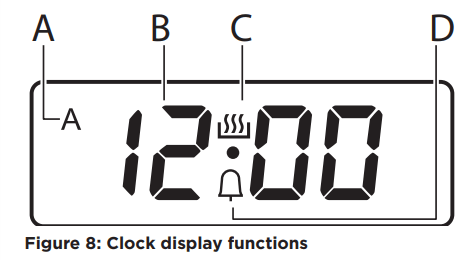
- A: Duration and End time indicator
- B: Time display
- C: Timer active indicator
- D: Active timer indicator
To set a timer function:
- For Duration (dur) and END (End), set an oven function and cooking temperature using the oven temp and oven mode knobs. (This is not necessary for
 .)
.) - Press timer on-off until the desired function option displays -- indicated by the bell symbol, dur, or END -- and starts to flash.
- Press
 or
or  to set the desired timer function. The timer function activates, and the corresponding indicator will appear in the display. For End and dur, A will also appear in the display. NOTE: When using the End function, set the time of day, not a number of minutes, The display will default to the current time.
to set the desired timer function. The timer function activates, and the corresponding indicator will appear in the display. For End and dur, A will also appear in the display. NOTE: When using the End function, set the time of day, not a number of minutes, The display will default to the current time. - When the time ends, the function’s indicator on the display will start flashing and an signal will sound for two minutes. Press any button to stop the signal.
IMPORTANT: With the Duration and End functions, the appliance will stop cooking automatically, and the oven indicator light will turn off.
To cancel the timer function:
- Press timer on-off until the desired function option appears.
- Press and hold
 or
or  at the same time. The timer function will go out after several seconds.
at the same time. The timer function will go out after several seconds.
To change the acoustic signal:
- To hear the current signal, press and hold
 .
. - Repeatedly press
 to change the signal.
to change the signal. - Release . The last tone you heard will be the new signal.
- Wait five seconds for the setting to be confirmed.
NOTE: When the appliance is disconnected from the outlet or after a power outage, the signal tone will be set back to the default tone.
Setting Bake
Use the bake feature whenever the recipe calls for baking using normal temperatures.
CAUTION
- Always use pot holders or oven mitts when using the oven. When cooking the oven interior, oven racks, and cooktop will become very hot which can cause burns.
- Do not bake foods directly on the oven bottom. To avoid damaging the oven interior and surfaces, always bake foods in the oven using bakeware positioned on an oven rack.
To set Bake:
- Arrange oven racks while the oven is still cool.
- Allow oven to preheat for 15 minutes before baking. Preheating is not necessary when cooking casseroles, or broiling most foods.
- Turn the oven mode knob to the bake position (Figure 9).
- Turn the oven temp knob to the desired temperature position (Figure 10).
- To cancel the baking function, turn the oven mode and oven temp knobs to the OFF positions.
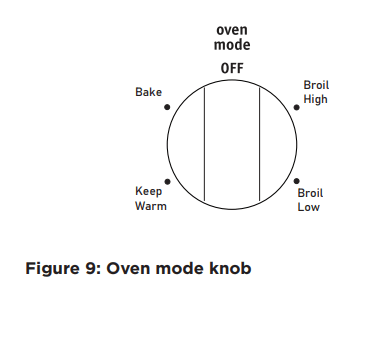
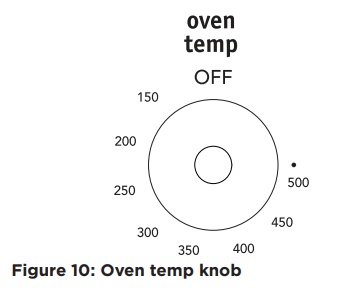
WARNING: Incorrect operation of the appliance or defective components can cause dangerous overheating. To prevent this, this appliance has a safety thermostat which interrupts the power supply. The appliance activates again automatically when the temperature drops.
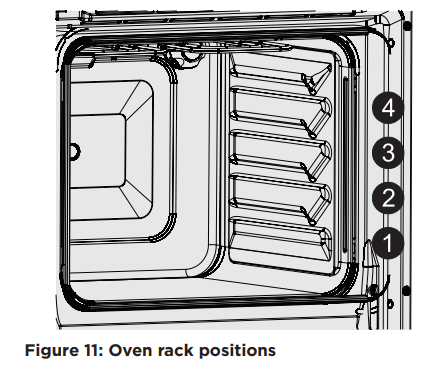
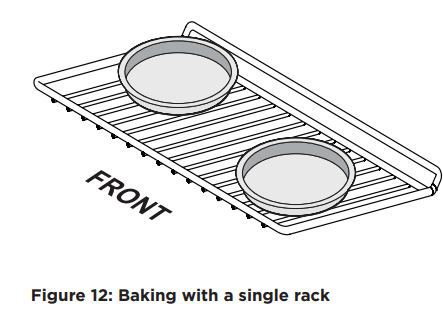
IMPORTANT: For this appliance, single rack radiant bake is the recommended bake function for best results for batter and dough-based baked goods such as cakes, pastries, and breads.
- For best results when baking with one oven rack, place racks in positions 2 or 3 (Figure 11).
- When baking using one oven racks, position bakeware as shown in Figure 12. Allow at least 2 inches (5 cm) of space between bakeware for proper air circulation.control knob to OFF position.
NOTE: The single rack baking image is correct, but it’s also for presentation purposes. You may also bake with the left pan in the front and the right pan in the back. Either position for either pan bakes correctly
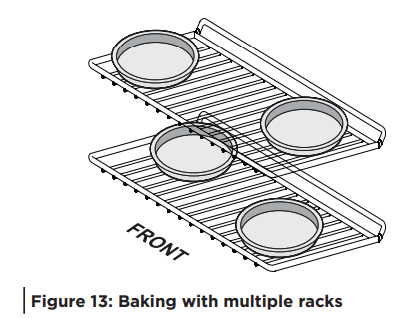
IMPORTANT: When baking using two oven racks, the pans on each rack must be swapped half way through the cook time for best results.
- For best results when baking cakes or cookies using two oven racks, place racks in positions 1 and 3 (Figure 11) and place pans as shown in Figure 13.
- Allow at least 2 inches (5 cm) of space between bakeware for proper air circulation.
General Baking Tips:
- Preheat the oven 15 minutes before baking items like cookies, biscuits, cakes, and breads.
- Dark or dull pans absorb more heat than shiny bakeware, resulting in dark or over browning of foods. It may be necessary to reduce the oven temperature or cook time to prevent over browning of some foods. Dark pans are recommended for pies. Shiny pans are recommended for cakes, cookies, and muffins.
- Do not open the oven door too often. Opening the door will reduce the temperature in the oven. • Glass bakeware is a slow heat conductor. May require reducing oven temperature.
Setting Broil
Use to cook meats that require direct exposure to radiant heat for optimum browning results. Position the rack as suggested in Table 3.
NOTE: Keep the oven door closed when broiling. The escaping heat could damage appliance knobs and controls.
To set Broil:
- Place the offset oven rack while the oven is still cool. Turn the oven mode knob to the Broil Hi position (Figure 9).
- Turn the oven temp knob to the desired temperature position (Figure 10). For optimum results, preheat broil for 15 minutes before adding food.
- Place the insert on the broil pan (if equipped), then place the food on the broil pan insert (if using a broiler pan and insert). To purchase a broiling pan and insert, visit frigidaire.com
- Place the broiler pan and insert on the oven rack. Center the broiler pan directly under the broiler element. Broil on one side until food is browned. Always pull the oven rack out to the stop position before turning or removing food. Turn and broil food on the second side.
- To cancel the broiling function, turn the oven mode and oven temp knobs to the OFF positions.
Table 3: Broil recommendations | ||||||
Food item | Rack Position | Mode | Temp | Cook time in minutes | Doneness | |
1st side | 2nd side | |||||
Steak 1” thick | 4 4 | HI | 500°F 500°F | 8:00 8:00 | 5:00 7:00 | Rare** Medium |
Pork Chops 3/4" thick | 3 o 4 | HI | 500°F | 8:00 | 6:00 | Well |
Chicken - Bone In | 3 | HI | 500°F | 20:00 | 10:00 | Well |
Chicken Boneless | 3 or 4 | HI | 500°F | 8:00 | 6:00 | Well |
Fish | 3 | HI | 500°F | 13:00 | -- | Well |
Shrimp | 3 | HI | 500°F | 5:00 | -- | Well |
Hamburger 1” thick | 4 3 or 4 | HI | 500°F 500°F | 8:00 8:00 | 5:00 7:00 | Rare** Medium |
The U .S . Department of Agriculture states, **Rare fresh beef is popular, but you should know that cooking it to only 140°F (60°C) means some food poisoning organisms may survive .” (Source: Safe Food Book, Your Kitchen Guide, USDA Rev . June 1985 .) The lowest temperature recommended by the USDA is 145°F (63°C) for medium rare fresh beef . For well done 170°F (77ºC) . All cook times shown are after 2 minutes of preheating . | ||||||
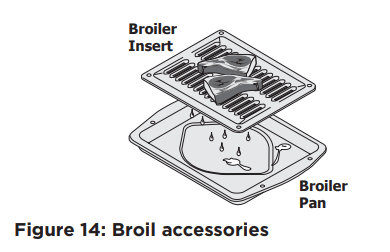
WARNING: Should an oven fire occur, keep oven door closed and turn off the oven. If the fire continues, throw baking soda on the fire or use a fire extinguisher. Do not put water or flour on the fire. Flour may be explosive and water can cause a grease fire to spread and cause personal injury. The broiler pan and the insert allow grease to drain and be kept away from the high heat of the broiler. Do not use the pan without the insert. Do not cover the insert with aluminum foil; the exposed grease could ignite.
CAUTION: Always use pot holders or oven mitts when using the oven. When cooking, the oven interior, oven racks, and cooktop will become very hot which can cause burns.
Keep Warm
Keep Warm should only be used with foods that are fully cooked and at serving temperatures. Warm will keep foods warm and ready for serving at 170° F (77°C) until canceled.
To set Warm:
- If needed, arrange oven racks and place cooked food in oven.
- Turn the oven mode knob to Keep Warm: WARM will appear in the display..
To turn Keep Warm off at any time, turn the oven mode knob to OFF.
Warning: Food poisoning hazard. Do not let food sit for more than one hour before or after cooking. Doing so can result in food poisoning or sickness.
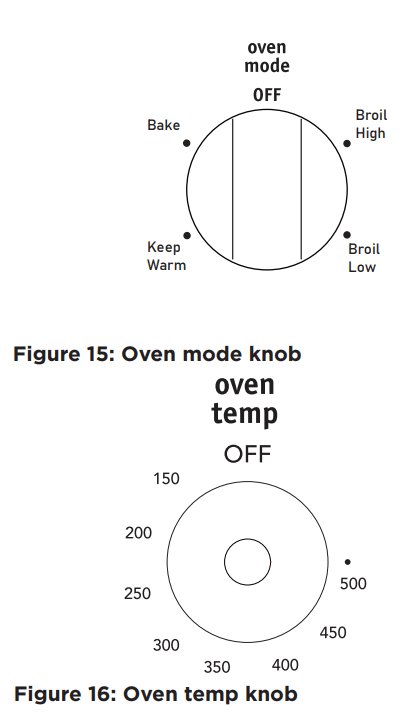
CARE AND CLEANING
Remove spills and any heavy soiling as soon as possible. Regular cleaning will reduce the difficulty of major cleaning later.
CAUTION
- Before cleaning any part of the appliance, be sure all controls are turned off and the appliance is cool.
- If ammonia or appliance cleaners are used, they must be removed and the appliance must be thoroughly rinsed before operating. Follow manufacturer's instructions and provide adequate ventilation.
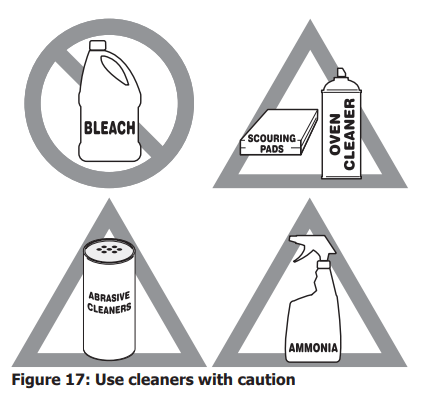
Surface or Area | Cleaning Recommendation |
Aluminum and vinyl | Using a soft cloth, clean with mild dish detergent and water . Rinse with clean water, dry and polish with a soft, clean cloth . |
Painted and plastic control knobs Painted body parts Painted decorative trims | Using a soft cloth, clean with mild dish detergent and water or a 50/50 solution of vinegar and water . Rinse with clean water, dry and polish with a soft, clean cloth . Glass cleaners may be used, but do not apply directly to surface; spray onto cloth and wipe . |
Control panel | Before cleaning the control panel, turn all controls off, activate oven lockout (on some models), and if needed remove any knobs from panel . Using a soft cloth, clean with mild dish detergent and water or a 50/50 solution of vinegar and water . Do not spray liquids directly on the oven control and display area . Do not use large amounts of water on the control panel - excess water on the control area may cause damage to the appliance . Do not use other liquid cleaners, abrasive cleaners, scouring pads, or paper towels - they will damage the finish . |
Control knobs | Using a soft cloth, clean with mild dish detergent and water or a 50/50 solution of vinegar and water . To remove control knobs: turn to the OFF position, grasp firmly, and pull off the shaft . To replace knobs after cleaning, line up the OFF markings and push the knobs into place . |
Stainless Steel | Using a soft cloth, clean with mild dish detergent and water or a 50/50 solution of vinegar and water . Rinse with clean water, dry with a soft clean cloth . Do not use cleaners containing abrasives, chlorides, chlorine, or ammonia . |
Smudge Proof™ Stainless Steel Black Stainless Steel | Using a soft cloth, clean with mild dish detergent and water or a 50/50 solution of vinegar and water . Rinse with clean water, dry with a soft clean cloth . Do not use appliance cleaner, stainless steel cleaner, or cleaner containing abrasives, chlorides, chlorine, or ammonia . These cleaners may damage the finish . |
Porcelain-enameled broiler pan and insert Porcelain door liner Porcelain body parts | Rinse with clean water and a damp cloth . Scrub gently with a soapy, non-abrasive scouring pad to remove most spots . Rinse with a 50/50 solution of clean water and ammonia . If necessary, cover difficult spots with an ammonia-soaked paper towel for 30 to 40 minutes . Rinse and wipe dry with a clean cloth . Remove all cleaners or future heating could damage the porcelain . Do not allow food spills with a high sugar or acid content (milk, tomatoes, sauerkraut, fruit juices or pie filling) to remain on porcelain surfaces . These spills may cause a dull spot even after cleaning . |
Manual clean oven interior | The oven interior is porcelain coated and safe to clean using oven cleaners . Always follow manufacturer's instructions for cleaners . After cleaning, remove any oven cleaner or the porcelain may become damaged during future heating . Do not spray oven cleaner on any electrical controls or switches . Do not spray or allow oven cleaner to build up on the oven temperature sensing probe . Do not spray cleaner on oven door trim, door gasket, plastic drawer glides, handles or any exterior surfaces of the appliance . |
Oven door | Use mild dish detergent and water or a 50/50 solution of vinegar and water to clean the top, sides, and front of the oven door . Rinse well . Glass cleaner may be used on the outside glass of the door . Ceramic smoothtop cleaner or polish may be used on the interior door glass . Do not immerse the door in water . Do not spray or allow water or cleaners to enter the door vents . Do not use oven cleaners, cleaning powders, or any harsh abrasive cleaning materials on the outside of the oven door . Do not clean the oven door gasket . The oven door gasket is made of a woven material which is essential for a good seal . Do not rub, damage, or remove this gasket . |
Coil elements and drip bowls
- Your cooking product includes a new generation of electric coil element. This electric coil element design follows/supports a change made to the UL Standard for Household Electric Ranges related to cooktop surface temperature detection. If ordering replacement electric coil elements, you must refer to the parts catalog to obtain the correct part number for the electric coil element that was designed to function with the specific model that was purchased.
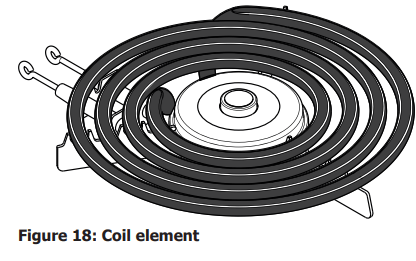
CAUTION
- Make sure drip bowls are in place - Absence of these bowls during cooking may subject wiring or components underneath to damage.
- Never immerse a surface element in water.
- Be sure the range is cool before removing surface elements or drip bowls. Be careful not to bend terminal ends when replacing surface elements after cleaning.
- Protective liners—Do not use aluminum foil to line surface drip bowls or reflector pans. Improper installation of these liners may result in risk of electric shock or fire.
Surface elements may be unplugged and removed to make cleaning the drip pans easier. The surface elements clean themselves when they are turned on. Food spilled on a hot element will burn off. Food spilled on a cool element may be cleaned with a damp cloth—any remaining soil will burn off the next time the element is used.
To remove the surface elements and drip bowls:
- Lift the edge of the drip bowl across from the terminal end. Lift the surface element and drip bowl together just enough to clear the cooktop.
- While holding the drip bowl and surface element, gently pull the terminal end out from terminal plug. Do not remove the hold-down clip (if equipped) from the drip bowl.

Cleaning drip bowls
Wash in hot, soapy water. Rinse and dry while still warm. Hard to remove, burned-on soil can be removed by soaking the drip bowls for about 20 minutes in a lightly diluted liquid cleanser or a solution of ammonia and water (1/2 cup ammonia to 1 gallon of water). A nylon scrubber may be used after soaking. Do not use abrasive cleaners or steel wool, they will scratch the surface. Always rinse with clean water and polish dry with a soft cloth.
To replace drip bowls and surface elements:
- Slide the terminal end on the element through the opening in the drip bowl.
- Align the element support to rest on the rim inside the drip bowl. If your drip bowl is equipped with a hold-down clip, align the element support opposite the terminal end with the slot in the hold-down clip, and snap into place.
- After the element is positioned in the drip bowl, line up the terminal end with the terminal plug as shown.
- Hold the surface element and drip bowl together as level as possible and firmly push the terminal end into the terminal plug. Make sure element terminal is seated properly into terminal plug. Make sure the surface element is level to reduce the hazard of cookware sliding off the element.
Replacing the Oven Light
CAUTION: Be sure the oven is unplugged and all parts are cool before replacing the oven light.
Replacing the oven interior light bulb:
The interior oven light is located at the rear of the oven cavity and covered with a glass shield. The glass shield must be in place whenever the oven is in use (Figure 23). Only use lamps with the same specifications.
- Put a cloth on the bottom of the interior of the appliance. It prevents damage to the lamp glass cover and the cavity.
- Turn electrical power off at the main source or unplug the appliance.
- Turn the lamp glass cover counterclockwise to remove it.
- Clean the glass cover.
- Replace the lamp with a suitable 300°C heatresistant lamp.
NOTE: Do not allow your fingers to touch the new bulb when replacing. This will shorten the life of the bulb. Use a paper towel or cotton glove while handling the new bulb when installing.
6. Replace glass oven lamp glass cover.
7. Turn power back on again at the main source (or plug the appliance back in).
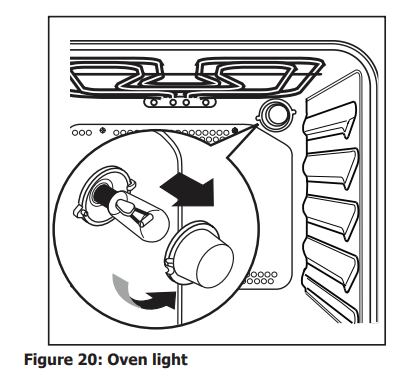
Removing and Replacing the Oven Door
CAUTION: The door is heavy. For safe, temporary storage, lay the door flat with the inside of the door facing down. Do not use the appliance without the internal glass panel.
To remove the oven door:
- Open the door fully, horizontal with the floor, and hold the two door hinges (Figure 21).
- Lift and turn/pull the levers on both of the door hinge locks down from the oven frame completely towards the oven door (Figure 22). A tool such as a small flat-blade screwdriver may be required.
- Firmly grasp both sides of oven door along the door sides. Do not use the oven door handle. Close the oven door halfway to the first opening position. Then, pull forward and remove the door from its seat (Figure 23).
- Put the door on a soft cloth on a stable surface (Figure 24).
- Clean the glass panel with water and soap. Dry the glass panel carefully.
IMPORTANT: Clean the oven door with a wet sponge only. Dry it with a soft cloth. Do not use steel wool, acids or abrasive materials as they can damage the oven surface. Clean the oven control panel with the same precautions.
IMPORTANT: Special door care instructions - Most oven doors contain glass that can break. Do not close the oven door until all the oven racks are fully in place. Do not hit the glass with pots, pans, or any other object. Scratching, hitting, jarring, or stressing the glass may weaken its structure causing an increased risk of breakage at a later time.

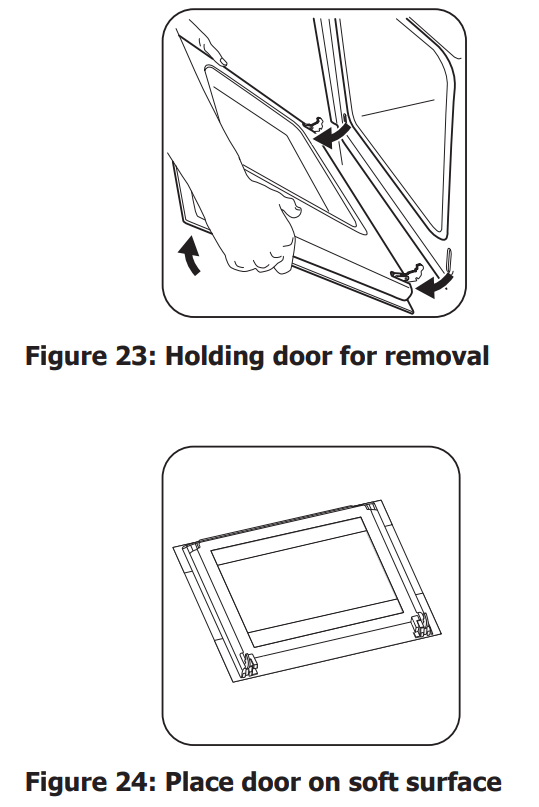
IMPORTANT: Special door care instructions - Most oven doors contain glass that can break. Do not close the oven door until all the oven racks are fully in place. Do not hit the glass with pots, pans, or any other object. Scratching, hitting, jarring, or stressing the glass may weaken its structure causing an increased risk of breakage at a later time.
To replace the oven door:
- Firmly grasp both sides of oven door along the door sides. Do not use the oven door handle (Figure 23).
- Holding the oven door at the same angle as the removal position, seat the hook of the hinge arm over the roller pins located on each side of the oven door frame (Figure 23). The hook of the hinge arms must be fully seated onto the roller pins.
- Fully open the oven door, horizontal with floor (Figure 21).
- Lift and turn/push the levers on both of the door hinge locks up towards and into the oven frame to the locked position (Figure 22).
- Close the oven door.
Aluminum Foil and Utensils
WARNING
- Never cover any slots, holes, or passages in the oven bottom or cover an entire oven rack with materials such as aluminum foil. Aluminum foil linings may trap heat, causing a fire hazard.
- Protective Liners — Do not use aluminum foil to line the oven bottom. Improper installation of these liners may result in risk of electric shock or fire
IMPORTANT
- Aluminum foil - Use of aluminum foil on a hot cooktop can damage the cooktop. Do not use thin aluminum cooking utensils or allow aluminum foil to touch the surface elements under any circumstances.
- Aluminum utensils - The melting point of aluminum is much lower than that of other metals. Care must be taken when aluminum pots or pans are used on the cooktop. If aluminum pans are allowed to boil dry when using the cooktop, not only will the utensil be damaged or destroyed, but it may fuse to or permanently damage the coil or cooktop.
Troubleshooting
BEFORE YOU CALL: For best cooking results, preheat the oven before baking cookies, breads, cakes, pies, pastries, etc. There is no need to preheat the oven for roasting meat or baking casseroles. The cooking times and temperatures needed to bake a product may vary slightly from your previously owned appliance
Baking Problems and Solutions Baking Problems | ||
Baking Problems | Causes | Corrections |
Cookies and biscuits burn on the bottom.  | Cookies and biscuits put into oven before oven is preheated. | Allow oven to preheat to desired temperature before placing food in oven. Choose pan sizes that will permit at least 2” of air space |
Cakes too dark on top or bottom  | Cakes put in oven before oven is preheated. Rack position too high or too low. Oven too hot. | Allow oven to preheat to the selected temperature before placing food in the oven. Use proper rack position for baking needs. Set oven temperature 25°F (13°C) lower than recommended. |
Cakes not done in center  | Oven too hot. Incorrect pan size. Pan not centered in oven. Glass cookware slow heat conductor. | Set oven temperature 25°F (13°C) lower than recommended. Use pan size suggested in recipe. Use proper rack position and place pan so there are at least 2” (5.1 cm) of space on all sides of pan. Reduce temperature and increase cook time or use shiny bakeware. |
Cakes not level.  | Oven not level. Pan too close to oven wall or rack overcrowded. Pan warped. Oven light left on while baking. | Place a marked glass measuring cup filled with water on the center of the oven rack. If the water level is uneven, refer to the installation instructions for leveling the oven. Use proper rack posiReltion and place pan so there are at least 2” (5.1 cm) of space on all sides of pan. Do not use pans that are dented or warped. Do not leave the oven light on while baking. |
Foods not done when cooking time is over.  | Oven too cool. Oven overcrowded. Oven door opened too frequently. | Set oven temperature 25°F (13°C) higher than suggested and bake for the recommended time. Be sure to remove all pans from the oven except the ones to be used for baking. Open oven door only after the shortest recommended baking time. |
Solutions to Common Problems
Before you call for service, review the following list. It may save you time and expense. Possible solutions are provided with the problem listed
Problem | Cause / Solution |
Entire appliance does not operate | Appliance not connected . Make sure power cord is plugged properly into outlet . Check your fuse box or breaker box to make sure the circuit is active . Electrical power outage . Check house lights to be sure . Call your local electric company for service outage information . |
Oven Problems | |
Problem | Cause / Solution |
Poor baking results . | Many factors affect baking results . Use proper oven rack position . Center food in the oven and space pans to allow air to circulate . Preheat the oven to the set temperature before placing food in the oven . Try adjusting the recipe's recommended temperature or baking time . |
Oven light does not work . | Be sure the oven light is secure in the socket . See “Replacing the Oven Light” on page 26 . |
Flames inside oven or smoking from oven vent . | Excessive spills in oven . Grease or food spilled onto the oven bottom or oven cavity . Wipe up excessive spills before starting the oven . If flames or excessive smoke are present when using broil, see “Setting Broil” on page 21 . |
Oven racks discolored or do not slide easily . | Clean by using a mild abrasive cleaner following manufacturer's instructions . Rinse with clean water, dry, and replace in oven . |
Oven smokes excessively when broiling . | Incorrect setting . Follow the “Setting Broil” instructions on page 21 . Meat too close to the broil element or burner . Reposition the broil pan to provide proper clearance between the meat and broil element or burner . Remove excess fat from meat . Cut remaining fatty edges to prevent curling, but do not cut into lean . Grease build up on oven surfaces . Regular cleaning is necessary when broiling frequently . Grease or food splatters will cause excessive smoking . |
Areas of discoloration with metallic sheen on cooktop surface . | Mineral deposits from water and food . Remove them using cooktop cleaning creme applied to the ceramic surface . Buff with a non-abrasive cloth or sponge . |
Surface element is too hot or not hot enough . | Incorrect surface control setting . Adjust power level setting . |
Surface element does not heat or does not heat evenly . | Be sure the correct surface control knob is turned on for the element needed . Cookware is light weight or warped . Use only flat, evenly balanced, medium or heavyweight cookware . Flat pans heat better than warped pans . Cookware materials and weight of the material affect heating . Heavy and medium-weight pans heat evenly . Because lightweight pans heat unevenly, foods may burn easily . |
Cooktop Problems | |
Problem | Cause / Solution |
Appliance is not level . | Be sure floor is level, strong, and stable enough to adequately support range . If floor is sagging or sloping, contact a carpenter to correct the situation . Poor installation . Place oven rack in center of oven . Place a level on the oven rack . Adjust leveling legs at base of appliance until the rack is level . Kitchen cabinet alignment may make range appear not level . Be sure cabinets are square and have sufficient room for appliance clearance . |
Cannot move appliance easily . Appliance must be accessible for service . | Cabinets not square or are built in too tightly . Contact builder or installer to make appliance accessible . Carpet interferes with appliance . Provide sufficient space so appliance can be lifted over carpet . |
Entire appliance does not operate . | Make sure power cord is plugged properly into outlet . Electrical power outage . Check house lights to be sure . Call your local electric company for service outage information . |
Fan noise during cooking operation . | A cooling fan may automatically turn on and off to cool internal parts . It is normal . |
Drip bowls are pitting or rusting . | Foods with acids, such as tomatoes, will cause corrosion if allowed to stand in/on bowls . When cool, remove and wash drip bowls as soon as possible after a spill . Normal environment - Houses located along sea coasts are exposed to salt air . Protect bowls as much as possible from direct exposure to salt air . |
Drip bowls have changing or distorting colors . | Bottom of cookware extends beyond surface element and touches cooktop surface . This can cause high enough temperatures to discolor drip bowls . DO NOT use cookware of this type . Pan sizes should match the size of the element . Replacement drip bowls may be purchased from your appliance dealer . |
See other models: LFUS2613LM FGEF3036TB FGBD2438PW FPMC3085PF FGHS2344KF
